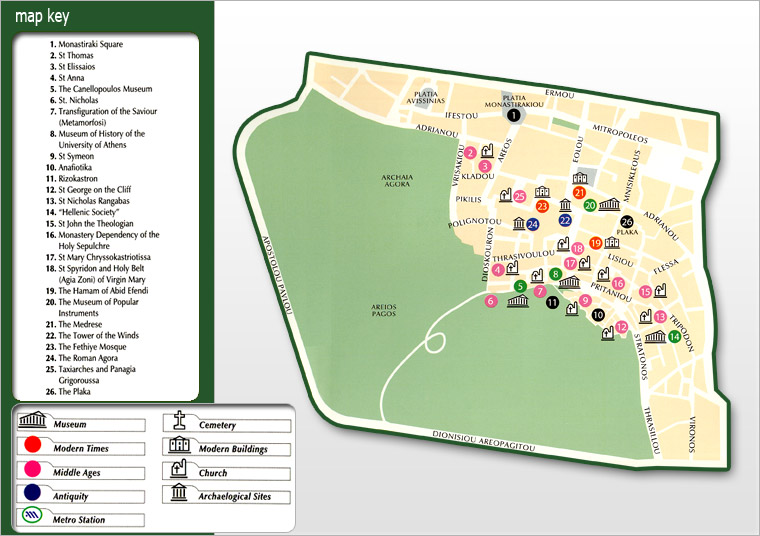Exploring Athens : Plaka walking in Athens old city
On the way out from the metro station of Thisseio, the visitor faces the best preserved ancient temple in Greece: the temple of Hephaestus. Situated on the top of a small hill in the ancient Agora, it used to be the heart of the city at the time of Pericles and Socrates. Nearby is the building of the Stoa of Attalos that today hosts the Museum of the Ancient Agora, where one can see finds related to the sociopolitical life of that era. After a tour around the ancient Agora, there is the option of an interesting walk in the shops and cafes in Monastiraki and on Avissinias Square.

1. Monastiraki
The vibrant and bustling Monastiraki is one of the most popular districts of Athens and one of the main commercial centers. The numerous commercial and tourist shops are open every day. Sunday morning is ideal for visiting the flea market and search in the piles of bric-a-brac in Avissinias Square. The monuments that surround Monastiraki reveal its history: Hadrian's Library, the Pantanassa, the Tzistaraki Mosque.
23. Fethiye Mosque
The Fethiye Mosque ("victory mosque"), in the area of the Roman Agora, was built in about 1458, after the arrival of Mehmet the Conqueror in Athens. From October 1678 to April 1688, after the conquest of Athens by the Venetian troops, it turned to a Catholic church. After the Greek War of Independence, it has been used as a school of music, as a military bakery and today it belongs to the Archaeological Society.
26. Plaka
Plaka is the oldest district of modern Athens and its complex street layout in many cases follows the ancient street plan. Being an integral part of Athens throughout the city's history, the ancient, Byzantine and ottoman monuments and ruins in its narrow streets travel us back in time. Plaka today is still the same as in late 19th and early 20th century and offers a unique opportunity of visiting an area of Athens that is characterized by singular beauty and seems to belong in different times.
24. The Roman Agora
The Roman Agora was the centre of commercial activity during Roman times. It was completed in 11 BC thanks to funds donated first by Julius Caesar and then by Octavian Augustus. The main surviving features include the monumental gate of Athena Archegetis, the central courtyard, which had an Ionian peristyle, the public latrines (Vespasianae), the Tower of the Winds, which was constructed by the astronomer Andronicus and operated as weather vane, water clock and sundial and which was converted during the Ottoman period into the tekke of the Dervishes, and the facade of a temple dedicated to Theoi Sebastoi.
10. Anafiotika
Anafiotika is one of the pleasant surprises of Plaka, a Cycladic-style quarter that was given this style by the craftsmen from Anafi who were engaged by king Otto to build the new capital after the independence and dwelled there. The small, whitewashed houses, the narrow, windy lanes and the small churches create an extremely interesting and nostalgic setting, that travels the visitor to Cyclades right in the heart of Athens!
16. Metochi Panaghiou Tafou
Metochi Panagiou Tafou is a typical church of the Ottoman period, today dedicated to Agioi Anargyroi. Originally, it was a monastery but now it is in the Dependence of the Holy Sepulcher. There is an interior courtyard with an old well and perhaps the only surviving early municipal gas lantern. It is one of the most known churches of Athens, mostly due to its close association with the practices of Holy Week: the Holy Light from Jerusalem first arrives here on Holy Saturday night and, on Good Friday, the traditional Epitaphios procession in the quaint alleys of the neighborhood takes place in piety and respect.


